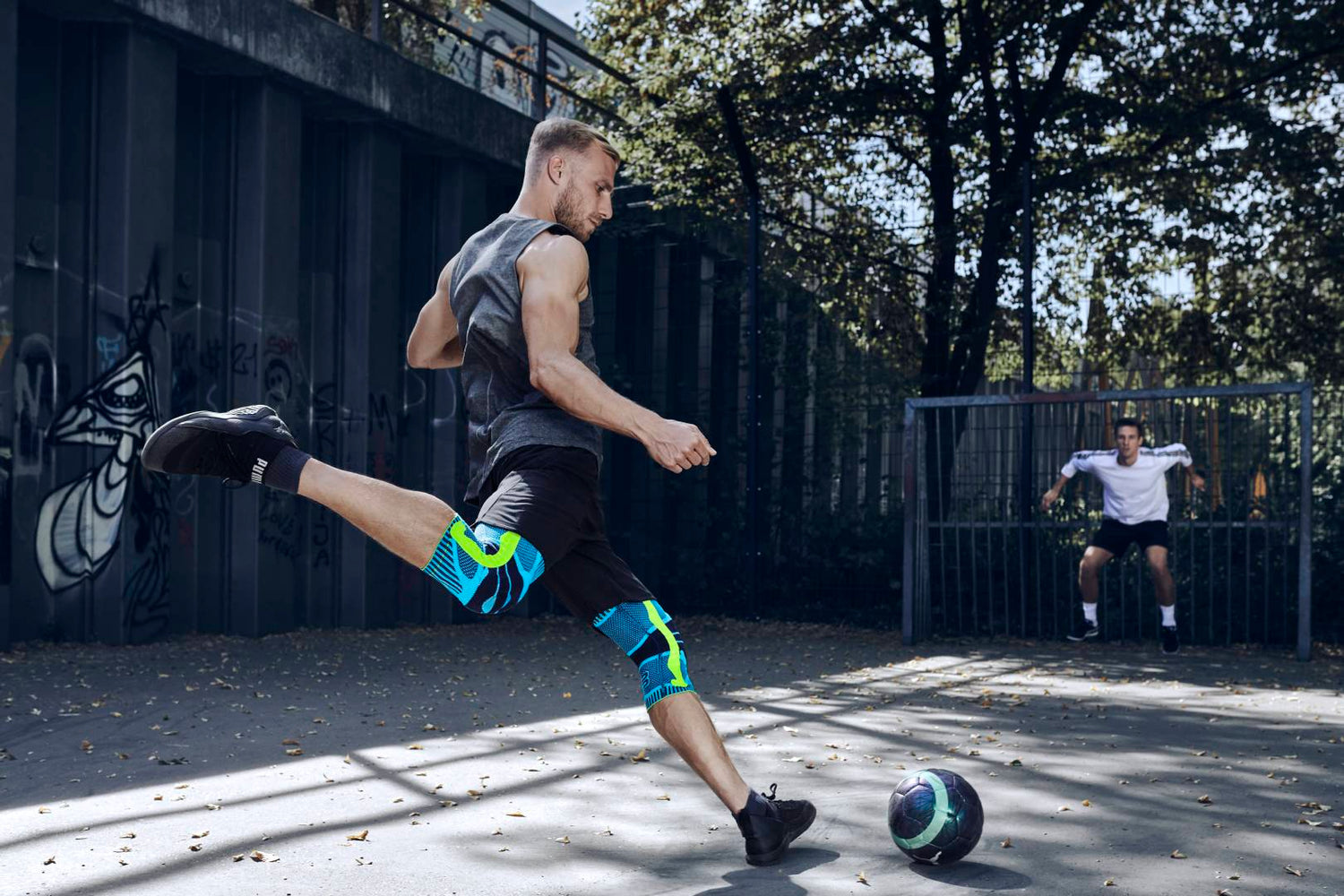Want to get better at soccer? Whether you play at the professional or recreational level, improving your performance won't be a particularly quick or easy process. But you can take a few steps to gradually help you improve. So, from drills to nutrition to bracing, here’s how to take your soccer training to the next level.
Fitness
Soccer demands a LOT from your body. According to Redbull, the average soccer player runs around 10 km in a 90-minute match. So, to keep up with the demands of the game, you’ll need to work on your fitness.
Strength
In soccer, the legs and core are the most important muscle groups. Your quads, glutes, calves and hamstrings determine how fast you run and how hard you kick, while your core muscles (transverse abdominis, abdominals, obliques, etc.) affect your balance and coordination. To train these muscle groups better, add the following exercises into your workout routine:
- Box jumps
- Mountain climbers
- Plank variants
- Deadlifts
- Dead bugs
- Isometric lunges
- Sumo squats
Aim to gradually increase the intensity of your workouts - every week, add a few more reps, a new exercise, or increase the weight you’re working with.
Aerobics
Some studies show that aerobic endurance training improves soccer performance by:
- Improving lactate threshold
- Increasing oxygen uptake
- Improving running economy
- And increasing involvement with the ball
Aerobic exercises like running, jogging, jumping rope, and cycling will make your muscles function more efficiently and help you become more confident on the field.
Drills

Practice makes perfect, and running drills with teammates is a surefire way to perfect your skills. Ideally, a drill session should consist of the following:
- Juggling. Kick the ball from foot to foot for as long as possible without letting it touch the ground.
- Zig zag. Set up some cones and zig-zag through them as fast as possible, both with and without the ball.
- Scoring. Practice getting the ball past a goalie from all ends of the court. Practice doing so on your own and while evading other players, from a slow run to a dead sprint.
- Wall passes. Kick the ball against a wall and control the rebound. Ideally, you should be able to control and kick the ball with one touch at a time.
- Dribbling. Set up some more cones and practice dribbling the ball around them. Work your way up to completing your cone course faster and with fewer touches.
- Passing. Practice passing the ball around with your teammates. Do so in grids that players can’t move in or out of to improve kicking precision and while running from one end of the field to the other to speed up your decision-making.
Nutrition
Supply your body with all the vitamins, nutrients, and energy it needs to help you through training and game day.
First, get a good mix of carbs, fats, and proteins.
- Carbs help restore your glycogen levels. Glycogen is the energy source your muscles rely on to power you through training, playing, and everyday life. If these stores run low or empty, your muscles will fatigue significantly faster, making you slower and weaker on the field.
- Proteins help build muscle tissue. Especially if you’re adding rigorous strength training into your routine, you’ll need to eat plenty of it to ensure your muscle fibres grow stronger, tougher, and more resilient.
- Fats are also an important energy source. Some research suggests it’s your body’s go-to fuel when doing lower-intensity exercises like jogging, swimming, and certain drills. Fats also help your body absorb essential vitamins (like D, A, E, and K).
Second, eat plenty of fresh fruits, veggies, and fatty fish to get the aforementioned vitamins. Vitamins A, E, and K will support regular bodily functions like balancing antioxidant levels and keeping your tissues healthy, and vitamin D will support muscle strength.
And third, always make sure your dietary input matches your energy output. Hitting a calorie deficit can lead to lower energy levels and a faster rate of fatigue. For the best outcomes, we’d recommend talking to a dietician to determine your ideal caloric intake. But as a general guide, players burn 1 calorie per kilo per hour per MET (Metabolic Equivalent, or how intense the exercise rates from 1-10). For example, a 70 kg player will burn around 280 calories doing a 4 MET activity (like during moderate agility drills) for an hour.
Compression

Sports Knee Support
Compression sleeves and braces have several benefits for soccer players.
- They reduce muscle fatigue. Quality compression improves circulation, helping your arteries move essential oxygen and nutrients into muscle tissue and remove waste products. With your muscles getting what they need faster, they’ll fatigue slower.
- Improve proprioception. Proprioception is essentially your ‘awareness’ of how you move. It determines how fast and how well you activate muscles, how your joints track, and how you manoeuvre through space (for example, how successfully you evade your marker). By communicating with your muscles, compression fabric helps them better transmit and receive messages to and from your brain, thus improving these processes.
- Speed up muscle recovery. Some studies found that wearing compression during training, matches, and recovery positively affects the body’s ability to repair exercise-induced muscle damage.
- Lower risk of injury. Soccer tends to cause acute and overuse injuries like sprains, strains, and tendonitis. By warming up the muscles through boosted blood flow and improving muscular control through proprioception, compression sleeves will help you avoid these injuries.
Recovery
You need adequate rest to perform at your best. I’ll help you restore your glycogen levels and let your muscles repair after physical activity. Not to mention, it’ll also help you avoid overuse and repetitive stress injuries like ITBS and Shin Splints, which can throw off your training routine and negatively affect how you play.
The first step of recovery starts with a cool down. Taking 15 minutes to do low-intensity exercises and stretches may reduce the intensity of Delayed Onset Muscle Soreness (DOMS), improve your range of motion, and help tissues heal a little faster. You can learn more about cooling down here.
The second step is cross-training and fitting rest days into your schedule. When strength training, you can do so for a few days in a row. But when you do so, focus on different muscle groups on certain days (for example, legs on Mondays, core days on Tuesdays, and upper body days Wednesdays. According to experts, you should also have a rest day every 3-5 training days. You can still do low-to-moderate level physical activities like walking or swimming, as long as you don’t overdo it and overload your overworked muscles. A muscle can take up to 72 hours to fully recover after intense physical activity. Continuously overworking it can lead to tissue degeneration instead of building.
And lastly, wear compression. Our Sports Recovery Socks will boost oxygen and nutrient delivery into healing muscles, speeding up the repair process.
Upskill
Pinpoint and work on your weaknesses. If you’re too slow to change direction on the field, run a few more agility drills and work on your core strength. If you need more explosive speed for evasion, try sprint training and work on strengthening your leg muscles. If your footwork while evading and passing the ball could use improvement, work on your proprioception and run more juggling and passing drills.
Additionally, try to squeeze in watching a few pro soccer matches into your schedule on the off chance you don’t do that already. A good way to improve your soccer skills is to see the best players at work.
To sum up
As with any sport, you won’t play like a pro in a week. But by wearing the right gear and working on your fitness, skills, nutrition, and recovery routine, you’ll improve your soccer training. And over time, see gradual improvements in your soccer performance on the field.
Explore more soccer supports: Soccer Supports & Braces
If you require assistance selecting the right product for your needs or wearing the brace, call us on 098015660 or contact us via live chat.
Do you have private health? Most private health extras will cover Bauerfeind Products. Check to see if yours is included. Bauerfeind Private Health Insurance Inquiry.
















